“The prosperous Kingdom of Greengully, ruled for centuries by the Forever King, has issued a decree to its citizens to colonize the vast lands beyond its borders. In an effort to start a new village, the Forever King has selected six citizens for the task, each of whom has a unique set of skills they use to build their charter.”
Way back in August of 2016, my fellow writer Jesse Fletcher predicted that legacy games were going to be the next big thing and he wasn’t wrong. As it stands now, the top two games on Boardgamegeek.com are both legacy games and it seems like a new legacy game is being announced on an almost weekly basis. I’ll be honest, I was resistant to the idea from the very start. Even though I found the concept of legacy games intriguing, the very idea of tearing up a game and turning it into something with zero replay value was abhorrent to me. And then I found out about Charterstone.
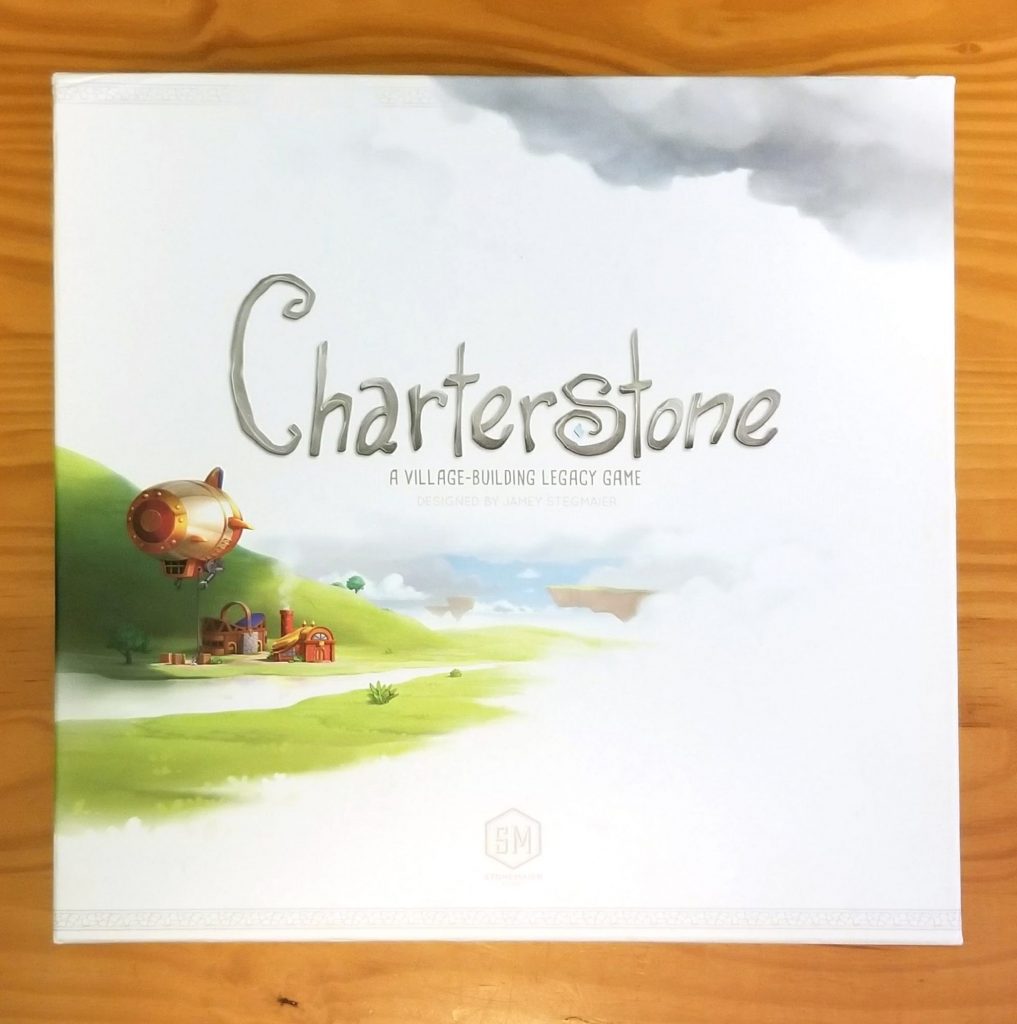
The concept is simple. Charterstone is a legacy game that, when complete, will be a fully replayable game unique to you. Your decisions that you make during the course of the game will permanently alter the state of the board. Other people that finish the 12-game campaign will also have fully replayable copies, but theirs will be almost entirely different from yours. So, how does it play as a legacy game? And more importantly, how does it live up to its promise of being a fully replayable game once the campaign is over and done with?
Before I answer these questions, I’m going to provide a brief rundown of some of the basic rules. There will be some minor spoilers, but nothing major. These will all be things that you’ll encounter and discover during the course of your very first game of the campaign. If that interests you, then read on. Or if you’re more of a video person, Rodney Smith from Watch It Played has an excellent introductory video that he’s put together. If you’re just interested in hearing what I think about the game, then feel free to scroll down to the Thoughts section.
For the rest of you, I will try to keep this as brief and spoiler free as possible…
Overview
Charterstone is a euro-style game that uses a combination of worker placement and resource management to build up your tiny village into a thriving metropolis over the course of a 12-game campaign. When the game first begins, your options are rather limited but as the campaign progresses, new rules, new concepts, new buildings, and new ways to score victory points are introduced. Most of the time, just WHAT gets introduced and WHEN depends entirely upon the choices that you and your group make during the course of the campaign. Once the campaign comes to a conclusion, an overall winner is declared and you are left with a final version of the game that can be played again and again – just without the legacy or campaign element.
Components
Charterstone comes packed in a beautifully illustrated box that is crammed full of stuff. Inside you’ll find a large, double-sided game board, two smaller game boards (the Advancement and Objective boards), a box labeled “Scriptorium” which contains all of the resource bits you’ll be starting the game with (metal coins and wooden resource tokens), another box called the “Index” which is crammed full of individually numbered cards, an empty tuck box labeled the “Archive”, and 6 Charter chests (one for each player color). Each Charter chest contains a large worker, a small worker, a victory point (VP) tracker, and 12 influence counters of a single color (black, red, yellow, green, blue, or purple). Also included in the box is a rule book (called the “Charter”) and rules for the Automa which are artificial intelligence (AI) elements that can optionally be introduced into the game. There are also four smaller boxes labeled with Roman numerals that contain hidden surprises that might be opened during the course of the campaign.

All of these components are of very high quality. The wooden bits are colorful and sturdy. The cards are nice and thick. This is primarily due to the fact that most of the cards also include a peel off sticker of some sort (which we’ll get to later). The rule book is mostly empty at first but, as the game progresses, new rules will be added to it. Overall, the production value of Charterstone is impressive.
Setup
At the beginning of the game, you’ll be emptying everything from the Charter chest of your chosen charter color. In the first game there won’t be much in there other than your pieces. However, in future games, there will be various other things in there such as your chosen Persona card. You receive this in Game #1 as a representation of whichever color you’ve chosen to play. The game board is placed in the center of the table. Next to this are placed the Advancement and Objective boards. These boards are seeded with cards from their respective decks. These decks start out rather small but will grow in size throughout the course of the campaign as new elements (such as buildings) are introduced.

Next, each player places their VP tracker on the 0 spot of the VP track. Then the Progression marker is placed onto the space that corresponds to the number of players. Finally, the Charter die is rolled and re-rolled until one of the active player colors comes up. That player will be the first player for the game. This basic setup will persist throughout each and every game.
Reputation and Progression
While most of the board will be taken up by the various building spots, there are two elements of the game board which are static. The first is the reputation track. Various game functions will allow players to place their influence counters on this track and once it is filled up, no other influence counters will be able to be placed on it. At the end of the game, players who have placed counters on this track may earn VP depending upon how much influence they have invested here.

Also of importance is the Progression track. As some of the various game functions are performed, they will cause the Progression marker to advance a space. Once the marker reaches the end of the track, the game comes to an end. Some of the spaces on the Progress track have icons on them which, when encountered, will cause some specific effects to occur.
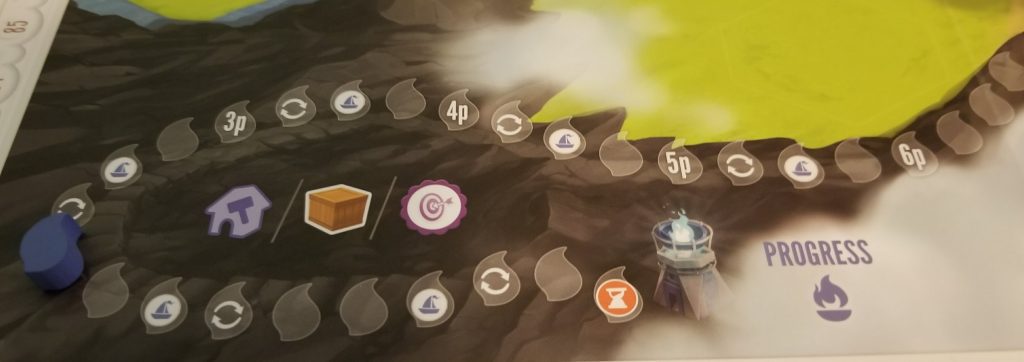
The Commons, the Cloud Port, and How to Use Them
When the game begins for the very first time, there will only be a limited amount of options available to each of the players. In the center of the game board are a group of buildings called “The Commons”. These buildings are static and will never change. While each of these buildings provides a different function, the process for utilizing them (and every building in future games) is always going to be the same. To the left of the building are icons which show the cost for placing the worker on the building space, if there is one. To the right of the illustration are icons which depict the effect that happens should the player choose to utilize the building to gain its rewards. For instance, the Treasury allows the player to discard a resource back to the general supply in order to gain a coin while the Market allows a player to discard a coin and a resource in order to take one of the face up cards from the Advancement board.

Also on the board is another location called the “Cloud Port”. The Cloud Port allows a player to use their influence markers to move on the reputation track, earn victory points, or both. Sometimes, depending upon the current game objectives, a player might even place an influence marker or two into this area even if it doesn’t provide them with any kind of benefit.
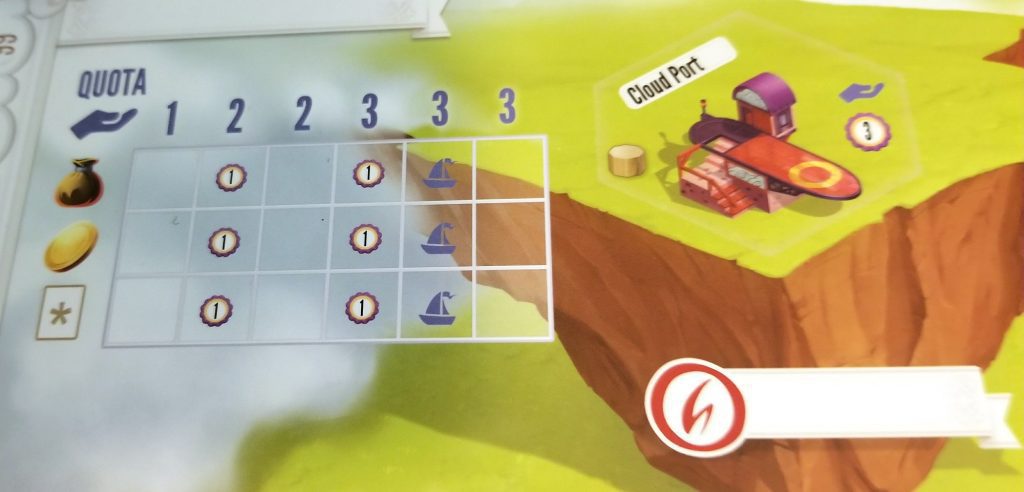
The game uses a “bump” mechanism when it comes to worker placement. If you place a worker on a location where there is already another worker, the old worker gets sent back to its owner. If you don’t have a worker to place because nobody’s bumped yours back to you, then your entire turn will be taken up collecting your workers and returning them to your personal supply.
The Thrill of Discovery
A central concept to Charterstone (and indeed to any legacy game) is the thrill of discovery. Whenever you construct a building by paying the costs shown on the card, you will be peeling off a sticker and placing the sticker onto the game board into your chosen charter. Some of these buildings depict wooden crates in their upper right hand corner. These building cards, once built, are kept in front of the player and are referred to as “constructed building cards”. Later on, the players can use various game functions such as the Charterstone space in The Commons to open the crate.

A player opening a crate will consult the list inside of the Index and this will instruct them to extract specific numbered cards from the box. These cards are how the players introduce new buildings, new rules, new personas, and new concepts into the game. This is the primary way that the game evolves over the course of the campaign.
End Game and Scoring
The end of the game is triggered once the Progression marker reaches the end of the Progression track. When the game ends the players receive extra VP based on where they sit on the reputation track and might even earn extra VP from various cards that they have in their possession. The person who has the most VP wins the game and will be able to fill in one of the trophies on their charter chest. The non-winners will be able to fill in a capacity bubble on their chests which will allow them to carry extra stuff from one game to the next.
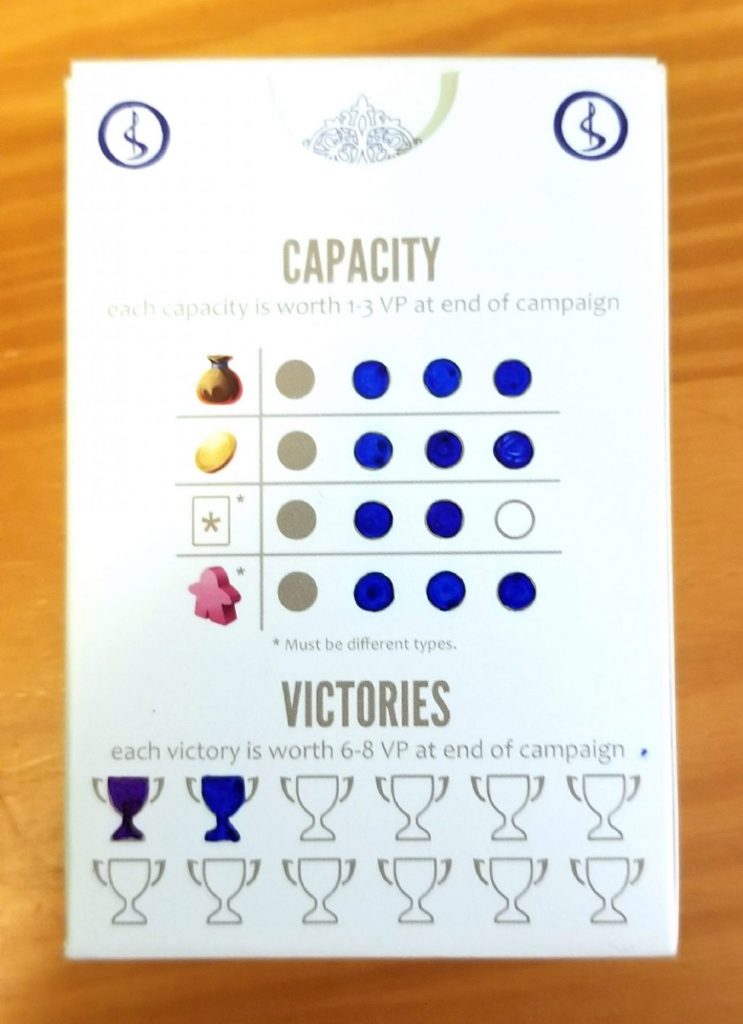
Each player also receives 1 glory star for every 10 points that they earned during the game. The stars are used to unlock various starting resources for future games. For instance, if a player fills in all of the glory stars next to the coin, then they will begin each game with at least one coin in their possession.
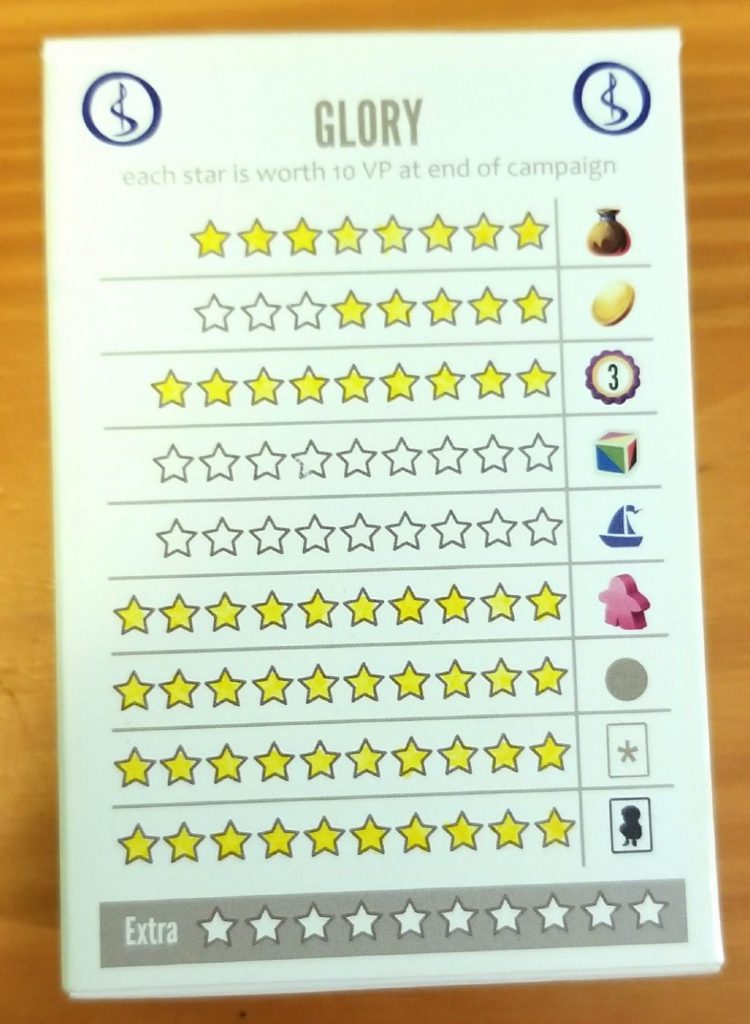
Thoughts
The first thing about Charterstone that really jumped out at me was the cover illustration done by Mr. Cuddington (which is actually the impressive artistic collaboration between the husband and wife duo, David Forest and Lina Cossette). The scene is vibrant, airy, and inviting. At the same time, there is a lot of negative space which leaves things feeling unfinished and, thematically, this fits well with the gameplay as the world at the beginning of the game is an open canvas just waiting for the players’ ministrations to make it complete. This artwork is brilliant in its execution and, after opening the box, this feeling of welcoming lightness never leaves you. The character illustrations are cheeky, fun, and endearing. Not a single one of the characters looks like they’d rather be doing anything other than living in Greengully. Even the building illustrations by Gong Studios have this same feeling about them. While they could easily have had a lifeless architectural look, they feel bubbly and almost alive instead.

The second thing that thrills me about Charterstone is the legacy aspect of the game. Each new mystery box opened, each new rule added to the Charter, each unlocked building, all combine to turn the game into something unique and interesting. Every moment played is a moment of discovery or anticipation of discovery. Each time a building comes up in the card row on the Advancement board, it’s an exciting moment because it means that the chance of getting to open a new crate is on the horizon. Opening new crates is exciting because you never know what is going to happen next. Being a legacy game, Charterstone has you making choices in one game that will have lasting effects on every other game played in the campaign. Charterstone has you immediately wanting to dive into the next session just to find out what happens next. Were it a TV show, you’d want to binge watch it in a single sitting. It’s that kind of game! This was my very first legacy game and now I understand what makes these games so unique. That sense of discovery and world-shaping just isn’t something that you can get from anywhere else.
Not everything about Charterstone is perfect, though. I do have a few reservations. Firstly, while the game play is compelling, the story that weaves through the campaign really isn’t. I was expecting phenomenal writing that would keep me guessing and on the edge of my seat, but that wasn’t what I got at all. The story was fine, but it wasn’t anything to get excited about. It served as a conduit to introduce new concepts and mechanics to the game, but not much else. My main problem with the game, though, was the Automa.

The Automa are A.I. elements that follow randomly proscribed actions that are introduced via a deck of cards. One card might send one of their workers to a random location while another might simply cause the Progression track to advance a space (or some mixture of these). It is this Progression track advancing mechanism that I find the most troubling. In order to use an action which causes this track to advance, a human player must first collect the resources necessary to do so. This takes time and effort and also means that the player must make decisions weighing VP gains versus game progression. The Automa don’t care about any of this. They simply cause the track to advance and they do this rapidly enough that it often brings the game to a swift and unsatisfying conclusion. Before you’ve had a chance to really accomplish anything, the Automa have ended the game and this really sucks the fun right out of playing. In any other kind of game, this wouldn’t matter. I would just not use them ever again. In a legacy game, though, there is no rewinding time and undoing things. You’re just stuck. I regret ever having used Automa in my games. For me, they left an indelible blight on an otherwise amazing experience. I do not recommend using them ever.
Eventually, our campaign came to an end, the scores were tallied, and I was declared the overall winner. Normally, in any other legacy game, I’d stick the game on a shelf or make some art sculpture out of it or something and never touch it again. Charterstone is different, though. Half of its appeal is that after your campaign, you’re going to be left with a unique, replayable worker placement game and, for me, that’s what was really exciting. More so than the act of constructing this world, I was also invested in constructing the end game. Each of my decisions made during the game were made with this ultimate end goal in mind. So, at this point, you might be wondering how the game plays post-campaign (PC). Well, let’s talk about that.
The obvious issue with playing Charterstone PC is finding someone to play the game with. If you set up the game in a public area or attempt to play it with people that have never played before, there is no avoiding the spoiler issue. It’s tantamount to standing on a chair in a public place and shouting out the finer plot elements of Game of Thrones through a megaphone. Even if you manage to find a group of other people that have finished their campaigns, the chances of you encountering something on their board that was never unlocked in your campaign are very high. If you’re able to get past that hurdle, though, or if you decide to just play your finished game solo, this is what you’ll find…
In the PC mode, you’ll be playing as a random charter color which is determined by rolling the charter die until you get a color that nobody else is playing yet. This means that, unless you played through the campaign with a full complement of six people, you’re likely to wind up playing a charter that isn’t very well-developed or, if it is, it’s been developed in a very haphazard fashion. This presents some pretty major obstacles to overcome – particularly if the people that you’re playing against happened to be assigned well-developed charters. Charters that were developed by players during the course of the campaign tend to have some kind of built-in synergy where each of the various buildings either works well with, or derives some benefit from the productions of, the other buildings.

Also unlike the campaign, you won’t be starting your game with items brought over from previous games. Pulling down VP during the PC game is much more difficult than it was during campaign mode. Each game is a new slate and you’ll be given a series of choices about what you want to begin your game with. This choice of starting resources is extremely important because it will most likely steer your strategy for the rest of the game.
I have found that Charterstone PC is still a very enjoyable game even though it doesn’t seem to make a lot of sense most of the time. It has become obvious to me that a lot of bad choices were made during the course of my campaign – at least as far as the PC game is concerned. Sure I won the campaign overall, but the end result isn’t a very synergistic one. While it’s possible to do random things to score points, it’s hard to look out over the board and develop an overall strategy or get a good point scoring engine going. Charterstone PC is like the Wild West of board games. While there’s a structure that lies beneath, each charter is a law unto itself. And that’s perfectly okay. While the end result is very weird, it’s still a very playable game. Charterstone definitely accomplishes what it sets out to do in this respect. In fact, because of our end result, we’ve decided to purchase a recharge pack so that we can go through it all over again just to see what we’ll wind up with next. I’m excited to get started!
I can see why Charterstone has climbed up the charts as quickly as it has. It definitely belongs there. Even after you’ve opened all of the crates and built all of the buildings, Charterstone is still full of surprises. I highly recommend giving this game a try!


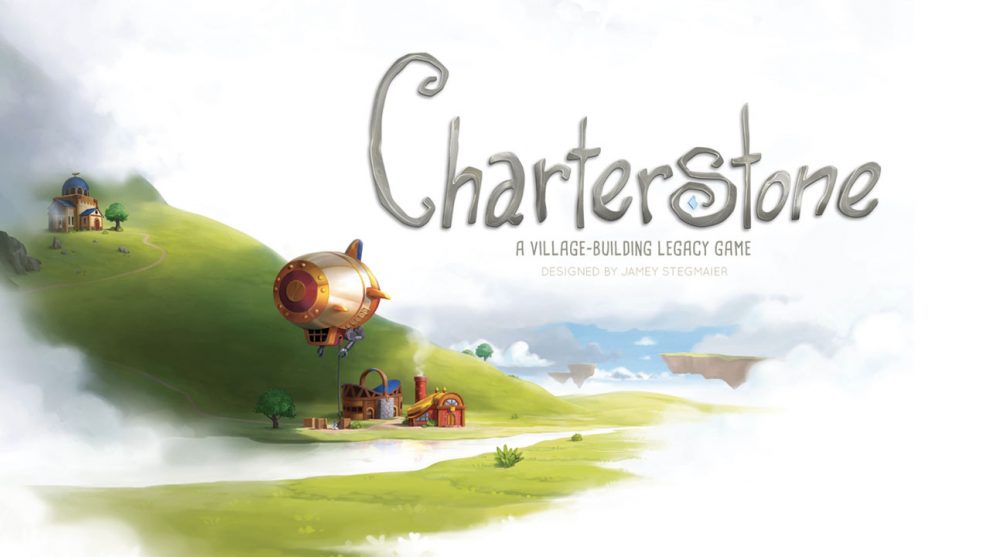









Add Comment